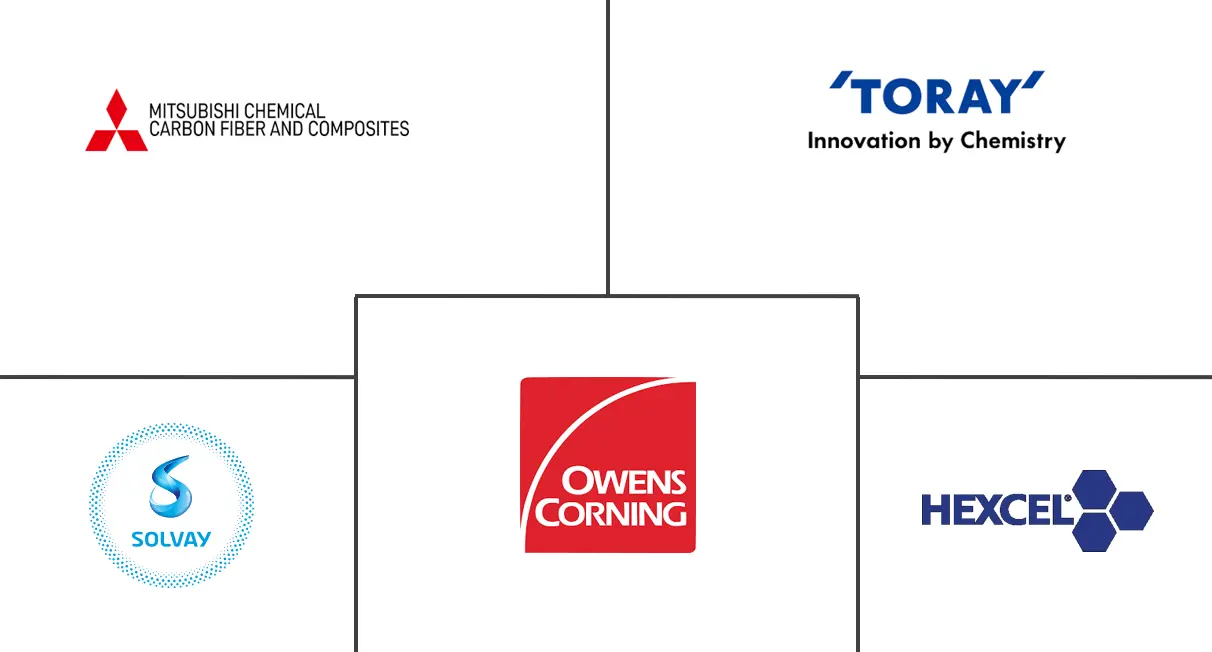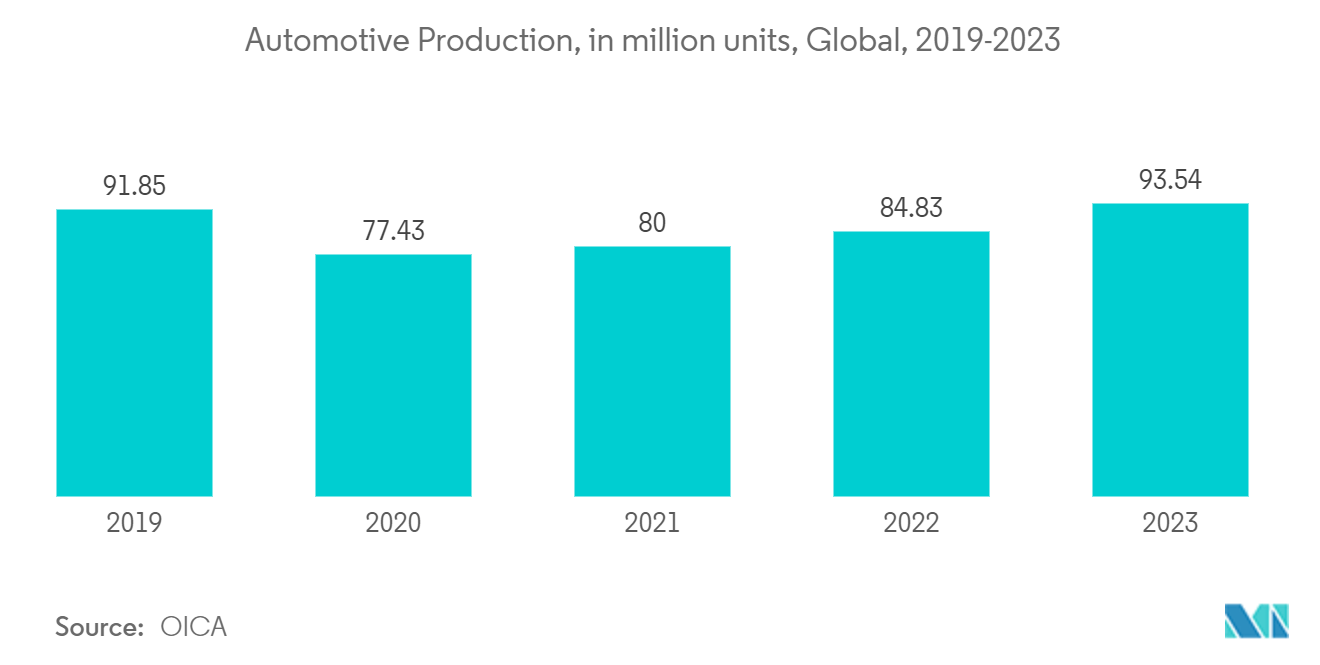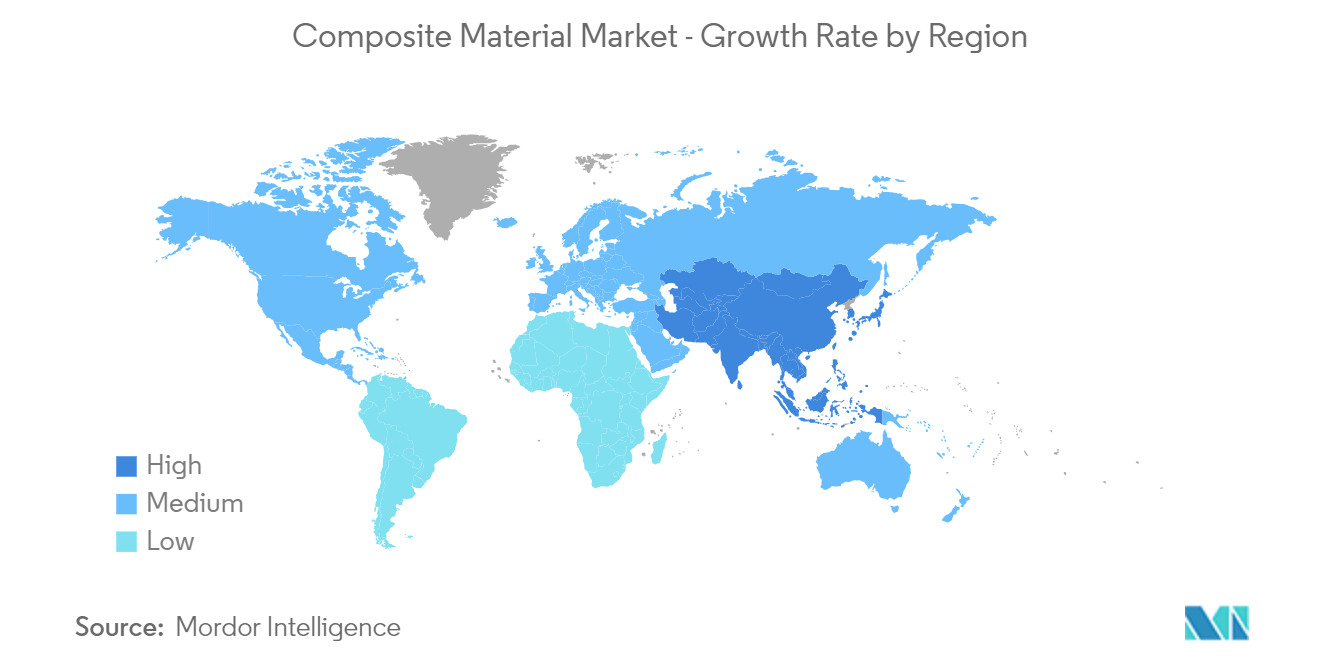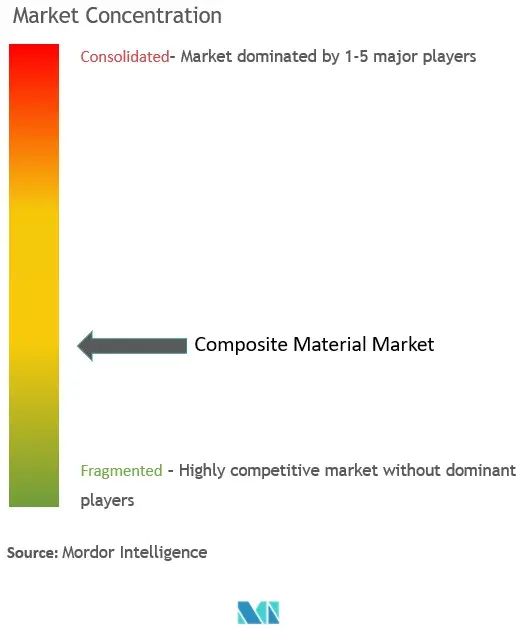Composite Materials Market Size

| Study Period | 2019 - 2029 |
| Market Size (2024) | USD 45.96 Billion |
| Market Size (2029) | USD 60.59 Billion |
| CAGR (2024 - 2029) | 5.00 % |
| Fastest Growing Market | Asia Pacific |
| Largest Market | Asia Pacific |
Major Players
*Disclaimer: Major Players sorted in no particular order |
Composite Materials Market Analysis
The Composite Material Market size is estimated at USD 45.96 billion in 2024, and is expected to reach USD 60.59 billion by 2029, growing at a CAGR of greater than 5% during the forecast period (2024-2029).
The market increased in 2021 compared to 2020. After the lifting of lockdowns in several countries and the resumption of many manufacturing and construction projects, the market has partially recovered from the negative effects of the COVID-19 pandemic.
- Recent improvements in technological advancements such as Nanotechnology, Out-of-Autoclave (OOA) Curing, and others in composite material manufacturing are expected to drive the growth of the market.
- On the other hand, high manufacturing costs, which result in a higher price for the end-user market, are expected to hinder market growth.
- Transportation application is expected to dominate the market studied in the forecasted period.
- Asia-Pacific has the largest share across the globe. The region is also expected to have the highest growth rate during the forecasted period.
Composite Materials Market Trends
Rising Demand from Transportation sector
- Composites are made up of two or more materials that have diverse physical and chemical characteristics. Polymer composites have long been proposed as a replacement for heavier metal components in the automobile industry, offering weight savings while retaining other desirable features such as mechanical strength. Carbon Fibre is the most preferred polymer composite for this application.
- Carbon Fiber is an advanced composite material used in a wide range of applications from Automotive to sports equipment and even in the most advanced industries such as Aerospace, Defense, and other industries.
- The number of carbon fiber manufacturers are increasing year on year due to its heavy demand in various markets. For instance, in 2021, there were 58 carbon fiber producers in the United States, up from 17 in the previous decade.
- Because of their high specific strength and/or modulus, composites have long been hailed as the materials of the future, making them appealing choices for aircraft applications. In the latest Boeing 787 Dreamliner aeroplane, the amount of composites has climbed to 50%.
- According to OICA, global automotive production increased from 84.83 million units in 2022 to 93.54 million units in 2023 with a y-o-y growth of 10.3%.
- Global efforts towards zero emissions by 2050 is another significant driver for composites in automotive industry, which in turn is leading to rapid development, innovation, and production of electric vehicles (EVs)
- In an effort to combat climate change, the UK government recently pledged to decrease 68% of CO2 emissions by 2030. To achieve this goal, new petrol and diesel automobiles woulds be be prohibited, and almost half of the UK's vehicles must be electric by the same year. This entails to replacing 16.1 million automobiles with electric vehicles (EVs), with only about 200,000 EVs now registered in the UK.
- Hence, owing to the above-mentioned factors, tranportation sector is expected to witness the highest growth rate during the forecast period.

Asia-Pacific to Witness the Highest Growth Rate
- Asia-Pacific region accounts for the highest share of composite material market owing to high demand from end-user industries like construction, automotive, electrical & electronics, aerospace & defense, Industrial, etc.
- The demand for composite material in the Asia-Pacific region is growing at a staggering rate as a result of rapid industrialization in countries such as China, India, and Japan.
- The demand for composite materials is surging every year with the increase in its application in various industries. In China the supply of Carbon fiber, which is an advanced composite fiber, amounted to around 19,250 metric tonnes in the year 2021 according to CompositesWorld.
- According to OICA, automotive production in China was at around 30.16 million units in 2023, with a y-o-y growth of 11.6% from the previous year, where the production was at around 27.02 million units. The steady increase in the Automotive sector would promote the growth of the composite market during the studied period.
- According to the Regulatory Affairs Professional Society, Japan's medical device market, with an estimated value of around USD 30 billion, ranks as the third biggest across the globe. Thus, increasing dependancy on medical equipments post COVID-19 would further boost the composite market.
- As per Inverted, a lithium battery manufacturer, India's ESDM (Electronics System Design & Manufacturing) sector is expected to reach USD 220 billion by 2025 and electronics manufacturing has been a crucial component of several government initiatives, including "Make in India," "Digital India," and "Start-up India." This factor would act as a potential growth opportunity for the studied market.
- According to JEC Korea, South Korea has a strong composites sector, with local processors and carbon fibre and resin suppliers, and the nation will continue to be at the forefront of composite material and method innovations. The government of South Korea has committed substantial resources to bolstering the country's carbon fibre sector.
- Increased usage of lightweight and extremely stiff carbon fibre is predicted to be stimulated by more rigorous environmental restrictions and the upgrading of environmental frameworks, such as the Sustainable Development Goals (SDGs) and the Paris Agreement. Asia's demand is said to be increasing, particularly in the domains of sports and outdoor activities, industrial, and aircraft.
- Owing to these prevailing market trends, the Asia-Pacific region is expected to dominate the global market.

Composite Materials Industry Overview
The composite material market is moderately fragmented as the market share is divided between many players. Some of the key players in the market (not in any particular order) include TORAY INDUSTRIES, INC., Owens Corning, Mitsubishi Chemical Corporation, Hexcel Corporation, Solvay and Teijin Limited, among others.
Composite Materials Market Leaders
-
TORAY INDUSTRIES, INC.
-
Owens Corning
-
Mitsubishi Chemical Corporation
-
Solvay
-
Hexcel Corporation
*Disclaimer: Major Players sorted in no particular order

Composite Materials Market News
- February 2024 - Owens Corning acquired USD 3.9 billion of Masonite. This acquisition would strengthen the company's position in building and construction materials and the glass reinforcement business within its Composites segment.
- June 2023 - Solvay is collaborating with Spirit AeroSystems. Both companies will engage in composite development. This merger would lead to collaborative research into sustainable aircraft technologies and processes with Spirit’s industrial, academic, and supply-chain partners.
Composite Materials Market Report - Table of Contents
1. INTRODUCTION
- 1.1 Study Assumptions
- 1.2 Scope of the Study
2. RESEARCH METHODOLOGY
3. EXECUTIVE SUMMARY
4. MARKET DYNAMICS
-
4.1 Drivers
- 4.1.1 Technological Advancement in the Field of Material Science
- 4.1.2 Increasing Use of Composites in the Aerospace and Defense Industry
- 4.1.3 Other Drivers
-
4.2 Restraints
- 4.2.1 High Cost of Composite Materials
- 4.3 Industry Value Chain Analysis
-
4.4 Porter's Five Forces Analysis
- 4.4.1 Bargaining Power of Suppliers
- 4.4.2 Bargaining Power of Consumers
- 4.4.3 Threat of New Entrants
- 4.4.4 Threat of Substitute Products and Services
- 4.4.5 Degree of Competition
5. MARKET SEGMENTATION (Market Size in Value)
-
5.1 Matrix Material
- 5.1.1 Polymer Matrix Composites (PMC)
- 5.1.1.1 Thermoset Resins
- 5.1.1.2 Thermoplastic Resins
- 5.1.2 Ceramic/Carbon Matrix Composites (CMCs)
- 5.1.3 Other Matrices (Metal Matrix Composites)
-
5.2 Reinforcement Fiber
- 5.2.1 Glass Fiber
- 5.2.2 Carbon Fiber
- 5.2.3 Aramid Fiber
- 5.2.4 Other Fibers
-
5.3 End-use Application
- 5.3.1 Automotive and Transportation
- 5.3.2 Wind Energy
- 5.3.3 Aerospace and Defense
- 5.3.4 Pipes and Tanks
- 5.3.5 Construction
- 5.3.6 Electrical and Electronics
- 5.3.7 Sports and Recreation
- 5.3.8 Other End-use Applications
-
5.4 Geography
- 5.4.1 Asia-Pacific
- 5.4.1.1 China
- 5.4.1.2 India
- 5.4.1.3 Japan
- 5.4.1.4 South Korea
- 5.4.1.5 Thailand
- 5.4.1.6 Malaysia
- 5.4.1.7 Indonesia
- 5.4.1.8 Vietnam
- 5.4.1.9 Rest of Asia-Pacific
- 5.4.2 North America
- 5.4.2.1 United States
- 5.4.2.2 Canada
- 5.4.2.3 Mexico
- 5.4.3 Europe
- 5.4.3.1 Germany
- 5.4.3.2 United Kingdom
- 5.4.3.3 France
- 5.4.3.4 Italy
- 5.4.3.5 Spain
- 5.4.3.6 Russia
- 5.4.3.7 NORDIC Countries
- 5.4.3.8 Turkey
- 5.4.3.9 Rest of Europe
- 5.4.4 South America
- 5.4.4.1 Brazil
- 5.4.4.2 Argentina
- 5.4.4.3 Colombia
- 5.4.4.4 Rest of South America
- 5.4.5 Middle-East and Africa
- 5.4.5.1 Saudi Arabia
- 5.4.5.2 South Africa
- 5.4.5.3 Nigeria
- 5.4.5.4 Qatar
- 5.4.5.5 Egypt
- 5.4.5.6 United Arab Emirates
- 5.4.5.7 Rest of Middle-East and Africa
6. COMPETITIVE LANDSCAPE
- 6.1 Mergers and Acquisitions, Joint Ventures, Collaborations, and Agreements
- 6.2 Market Share (%)**/Ranking Analysis
- 6.3 Strategies Adopted by Leading Players
-
6.4 Company Profiles
- 6.4.1 3M
- 6.4.2 DuPont
- 6.4.3 DIT B.V.
- 6.4.4 COMPOSITES UNIVERSAL GROUP
- 6.4.5 Hexcel Corporation
- 6.4.6 Materion Corporation
- 6.4.7 Mitsubishi Chemical Group Corporation
- 6.4.8 Owens Corning
- 6.4.9 SGL Carbon
- 6.4.10 Solvay
- 6.4.11 TEIJIN LIMITED.
- 6.4.12 TORAY INDUSTRIES, INC.
- *List Not Exhaustive
7. MARKET OPPORTUNITIES AND FUTURE TRENDS
** Subject To AvailablityComposite Materials Industry Segmentation
Composite materials are made by combining two or more materials with different properties without blending or dissolving them into each other. The global composite material market is segmented by matrix material, reinforcement fiber, end-use application, and geography. By matrix material, the market is segmented by polymer matrix composites(thermoset resins, thermoplastic resins), ceramic/carbon matrix composites, and other matrices(metal matrice composites). On the basis of reinforcement fiber, the market is segmented by glass fiber, carbon fiber, aramid fiber, and others. Similarly, by end-use application, the market is segmented into automotive and transportation, wind energy, aerospace and defense, pipes and tanks, electrical and electronics, sports and recreation, and other end-use applications. The report also offers market size and forecasts for 27 countries across major regions. For each segment, market sizing and forecasts have been done on the basis of revenue (USD).
| Matrix Material | Polymer Matrix Composites (PMC) | Thermoset Resins |
| Thermoplastic Resins | ||
| Matrix Material | Ceramic/Carbon Matrix Composites (CMCs) | |
| Other Matrices (Metal Matrix Composites) | ||
| Reinforcement Fiber | Glass Fiber | |
| Carbon Fiber | ||
| Aramid Fiber | ||
| Other Fibers | ||
| End-use Application | Automotive and Transportation | |
| Wind Energy | ||
| Aerospace and Defense | ||
| Pipes and Tanks | ||
| Construction | ||
| Electrical and Electronics | ||
| Sports and Recreation | ||
| Other End-use Applications | ||
| Geography | Asia-Pacific | China |
| India | ||
| Japan | ||
| South Korea | ||
| Thailand | ||
| Malaysia | ||
| Indonesia | ||
| Vietnam | ||
| Rest of Asia-Pacific | ||
| Geography | North America | United States |
| Canada | ||
| Mexico | ||
| Geography | Europe | Germany |
| United Kingdom | ||
| France | ||
| Italy | ||
| Spain | ||
| Russia | ||
| NORDIC Countries | ||
| Turkey | ||
| Rest of Europe | ||
| Geography | South America | Brazil |
| Argentina | ||
| Colombia | ||
| Rest of South America | ||
| Geography | Middle-East and Africa | Saudi Arabia |
| South Africa | ||
| Nigeria | ||
| Qatar | ||
| Egypt | ||
| United Arab Emirates | ||
| Rest of Middle-East and Africa |
Composite Materials Market Research FAQs
How big is the Composite Material Market?
The Composite Material Market size is expected to reach USD 45.96 billion in 2024 and grow at a CAGR of greater than 5% to reach USD 60.59 billion by 2029.
What is the current Composite Material Market size?
In 2024, the Composite Material Market size is expected to reach USD 45.96 billion.
Who are the key players in Composite Material Market?
TORAY INDUSTRIES, INC., Owens Corning, Mitsubishi Chemical Corporation, Solvay and Hexcel Corporation are the major companies operating in the Composite Material Market.
Which is the fastest growing region in Composite Material Market?
Asia Pacific is estimated to grow at the highest CAGR over the forecast period (2024-2029).
Which region has the biggest share in Composite Material Market?
In 2024, the Asia Pacific accounts for the largest market share in Composite Material Market.
What years does this Composite Material Market cover, and what was the market size in 2023?
In 2023, the Composite Material Market size was estimated at USD 43.66 billion. The report covers the Composite Material Market historical market size for years: 2019, 2020, 2021, 2022 and 2023. The report also forecasts the Composite Material Market size for years: 2024, 2025, 2026, 2027, 2028 and 2029.
What are the challenges facing the Composites Material Market?
The challenges facing the Composites Material Market are a) High cost of composites compared to traditional materials like steel and aluminum b) Difficulties in recycling composites, especially those with thermoset resins
What are the challenges facing the Composites Material Market?
The challenges facing the Composites Material Market are a) High cost of composites compared to traditional materials like steel and aluminum b) Difficulties in recycling composites, especially those with thermoset resins
Composites Industry Report
The global composites material market is experiencing significant growth, driven by the demand for lightweight, high-performance materials in industries such as automotive, aerospace, and construction. Segmented by fiber type, resin type, and manufacturing process, glass fiber composites, and thermoset resins are prominent due to their strength and environmental resistance, with the filament winding process noted for its efficiency in producing durable structures ideal for aerospace and automotive applications. Market dynamics are influenced by stringent environmental regulations promoting fuel-efficient vehicles, boosting the use of lightweight materials. However, the high cost and complex recycling of composites pose challenges, affecting growth for composite manufacturing companies. Despite these hurdles, opportunities in developing carbon fiber composites for high-pressure storage and in emerging technologies like eVTOL aircraft are significant. These developments are vital for companies aiming to innovate and expand in the composites industry. For detailed insights, Mordor Intelligence™ provides statistics on market share, size, and growth, including a forecast outlook and historical overview, available as a free PDF download.



